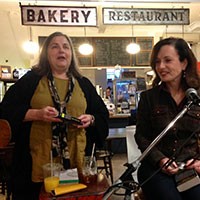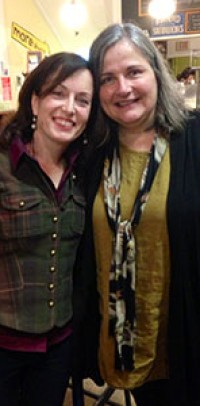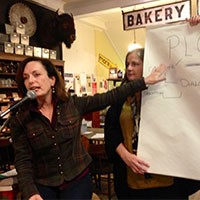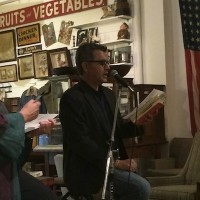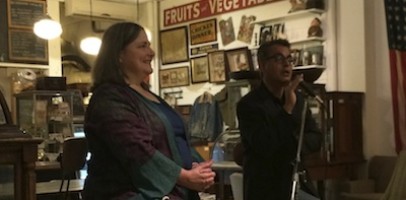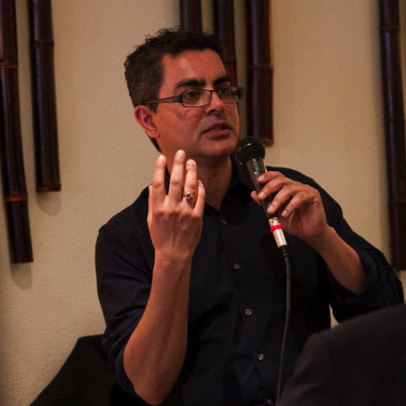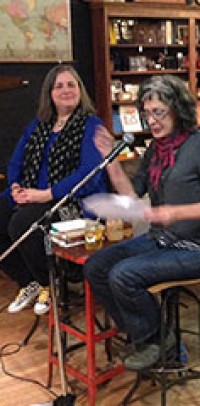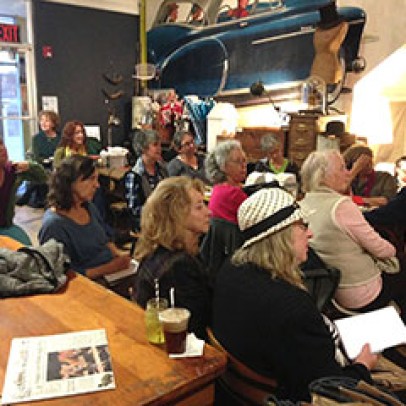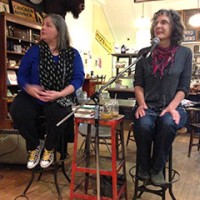ALISON GAYLIN‘s debut book Hide Your Eyes was nominated for an Edgar Award in the Best First Novel category. Her critically acclaimed suspense novels have been published in such countries as the UK, France, Germany, The Netherlands, Norway and Japan. She has been nominated for the ITW Thriller, Anthony and RT Awards and won the Shamus Award for And She Was, the first book in the Brenna Spector series. Her books have been on bestseller lists in the US and Germany. She is currently at work on her ninth book, a standalone suspense novel entitled What Remains of Me, which will be released in 2015 from HarperCollins. She lives in Woodstock with her family.
“The Plot Thickens” 10/9/14 – The Exercises
Alison Gaylin treated us to a galvanizing reading of the prologue to her latest Brenna Spector mystery, Stay With Me.
Our theme was “The Plot Thickens”–how to build conflict and suspense–and Alison’s reading exemplified the chart she displayed, with PLOT “at the top of the food chain,” right above CHARACTER and ACTION (connected to each other by DIALOGUE, with DESCRIPTION and PACING feeding both). Some plot tips from Alison:
— Start in mid-scene, with something important about to happen
— The more urgent a character’s need, the more compelling the story becomes
— If two characters’ needs are at cross-purposes, conflict builds naturally
— If one character needs information from another, give then an opinion about each other to animate the scene. The waitress is irritated by the cop who’s questioning her, the cop is attracted to her, etc.
Even though plot is king, you do not need to have the whole story in view when you start your first draft. Alison cited E.L.Doctorow’s analogy of driving at night, only able to see as far as the headlights reach. She likes to have a sense of where she’s headed (“I’m heading for LA, but I may take a northern rather than a southern route, or wind up in San Francisco instead of LA. But I know I’m heading west.”) If you get lost along the way, go back and see what you have so far. Often you’ve instinctively included a character or incident you can make use of later.
Rewriting involves ruthless cutting. If it doesn’t move the plot forward, it goes into the discard file. (Note it’s not deleted, but saved in a separate file, because it might be useful later, or in something else.)
When Alison was starting out, she didn’t feel she was as good as plot as characters and dialogue, so read 100 crime novels of all kinds–Dostoevsky to James M. Cain, Elmore Leonard, and Laura Lippmann–to study how they worked.
Nina offered a redux of the three-act “story arc” in screenwriting:
Act One: Character gets up a tree (i.e. start on the day something changes)
Act Two: People throw rocks at him (i.e. obstacles he must face)
Act Three: He gets down on the other side (i.e. changed by the journey)
Alison says she writes for the pleasure of being scared. “If I scare myself, I’ll scare the reader.”
The best villains have unexpected good qualities, and the best heroes have flaws and weaknesses. This shadow side will create a three-dimensional character.
ALISON’S EXERCISE:
Think of the most heinous action you can imagine (but something you want to write about). Now think of the most noble action. Write a scene in which your character is doing one of these two actions, and the other is in that character’s past and comes into play in the current scene.
NINA’S EXERCISE:
Your character boards a train at the last minute and rushes into an empty seat, sitting on a discarded newspaper. Then realizes there’s something underneath it. What is it, and what does the character do?
